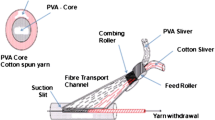Abstract
Geometrical shape of fibre cross section affects its degree of association with the surrounding fibres and thereby decides physical, mechanical and functional properties of yarn. While a circular cross section brings close proximity between fibres, non-circular fibres inhibit this. Proximity between fibres affects inter-fibre spaces and thus many properties of yarn and corresponding fabrics. The present study, reports on the influence of profiled polyester fibre with micro-channels on its surface and within on the fibre packing and wicking behavior of spun yarn. Five profile polyester fibres, viz; 4DG, circular hollow, conjugate hollow, octalobal and trilobal were used in the study. Yarns made from conjugate and trilobal fibres were found to have highest and lowest packing fraction respectively. Wicking height and wicking rate was the maximum for octalobal fibre yarn followed by 4DG and hollow, trilobal and conjugate fibre yarn. The doubled yarns have shown greater wicking height and wicking rate in comparison to single yarn.







Similar content being viewed by others
References
E. Kissa, Text. Res. J. 66, 660–668 (1996)
Y.K. Kamath, S.B. Hornby, H.D. Weigmann, M.F. Wilde, Text. Res. J. 64, 33–40 (1994)
T.L. Staples, D.G. Shaffer, Elsevier A: Physicochemical and engineering aspects 204, 239–250 (2002)
Y. Hseih, Text. Res. J. 65, 299–307 (1995)
A. Perwuelz, P. Mondon, C. Claude, Text. Res. J. 70, 333–339 (2000)
R. Chattopadhyay, A. Chauhan, Seminar on comfort in textiles (I I T, New Delhi, 2004)
R. Chattopadhyay, Melliand Int. 11, 25 (2005)
A. Khoddami, C.M. Carr, R.H. Ging, Fibers Polym. 10(4), 452–460 (2009)
S.S. Mahesh, S.K. Punj, B. Banwari, Indian J. of Fibre and Text. Res. 31, 313–319 (2006)
G.K. Tyagi, G. Khrishna, S. Bhattacharya, P. Kumar, Indian J. of Fibre and Text. Res. 34, 137–143 (2009)
E. Karaca, N. Kahraman, S. Omeroglu, B. Becerir, Fibres Text. East. Eur. 20(92), 67–72 (2012)
M. Matsudaira, Y. Tan, Y. Kondo, J. Text. Inst. 84(3), 376–386 (1993)
M. Matsudaira, Y. Kondo, J. Text. Inst. 87(3), 276–286 (1996)
Author information
Authors and Affiliations
Corresponding author
Rights and permissions
About this article
Cite this article
Datta Roy, M., Chattopadhyay, R. & Sinha, S.K. Wicking Performance of Profiled Fibre Part A: Assessment of Yarn. J. Inst. Eng. India Ser. E 98, 155–163 (2017). https://doi.org/10.1007/s40034-017-0097-9
Received:
Accepted:
Published:
Issue Date:
DOI: https://doi.org/10.1007/s40034-017-0097-9




